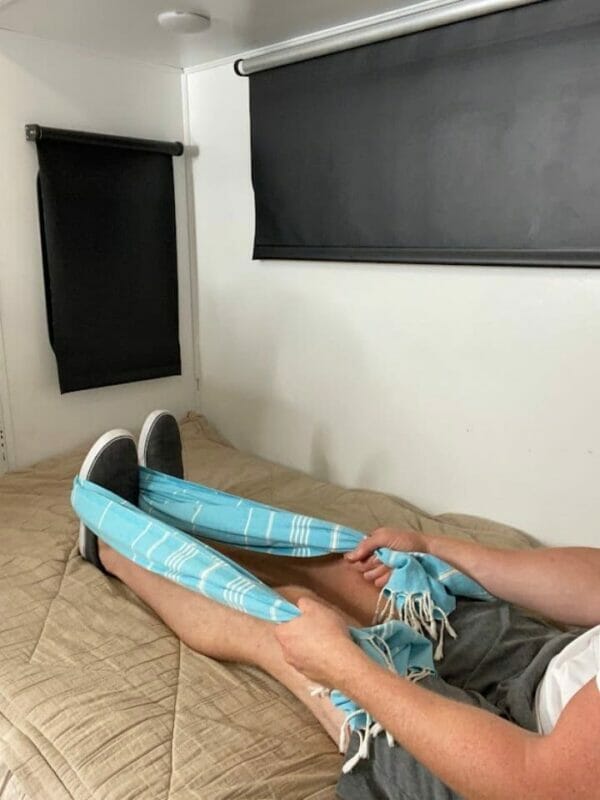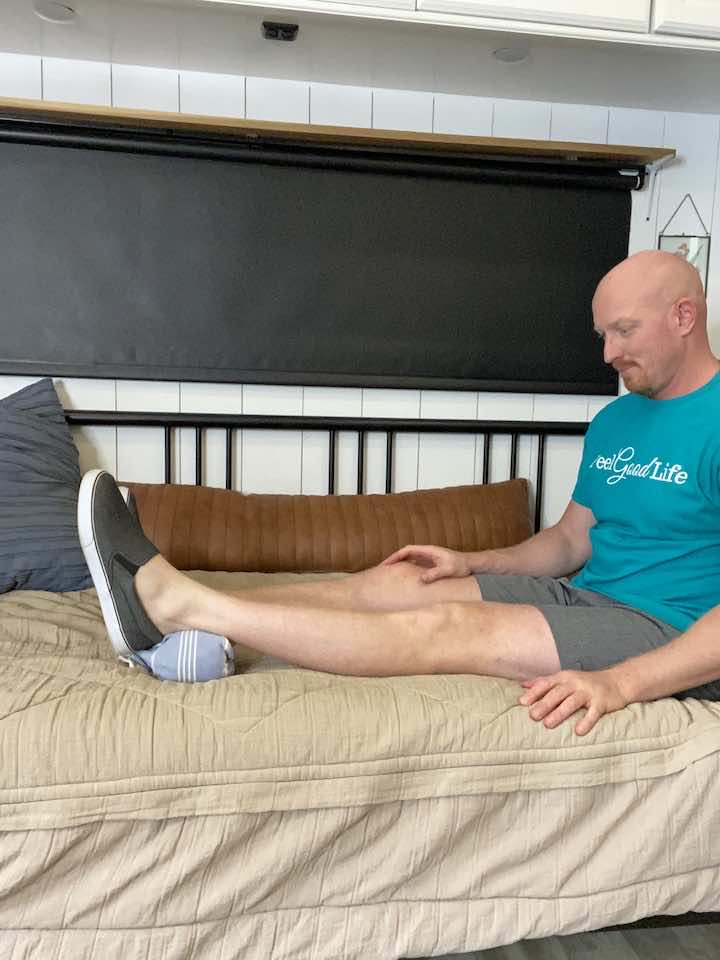Free download: Top 10 Natural & Easy Remedies for Joint Pain from Home. Learn these helpful remedies.
Estimated Reading Time: 8 minutes read
The knee joint is really important for our body because it supports our weight and helps us move. But sometimes people might feel stiffness or pain in their knees. Luckily, one way to prevent and manage knee issues is to do exercises that make your knees more flexible and help them move better. By taking care of our bodies and doing exercises regularly, we can live healthy and happy lives!
In this article, we’ll talk about the importance of knee flexibility, how far a normal knee can move, things that can stop your knee from moving properly, and why it’s important to do exercises to improve knee flexibility. We’ll also show you eight exercises that can make your knees move better and keep them healthy, so you can walk and run without any pain.
Table of Contents
Why is Knee Extension Crucial?
The knee joint is a very complex and important part of the body. It is made up of bones, cartilage, ligaments, and tendons that work together to support our body weight and help us move. One important aspect of the knee is its ability to straighten, which is called knee extension. This is important for things like walking, running, and jumping. When our knees can fully extend, these activities become easier and more comfortable.
What is the Regular Knee Range of Motion?

The knee joint can move in different ways, and the normal range of motion depends on the movement. When the knee bends, it’s called knee flexion, and the normal range is 135 degrees. When the knee straightens, it’s called knee extension, and the normal range is 0 degrees.
The knee can also rotate, and the normal range for internal rotation is 10 degrees, while for external rotation it’s 30-40 degrees.
Passive range of motion is when an external force, like a therapist or gravity, moves the joint. For the knee, the normal passive range for knee flexion is up to 150 degrees, which means the knee can bend further when an external force moves it.
On the other hand, the normal passive range for knee extension is up to 10 degrees beyond the active range, meaning the knee can straighten a bit more when an external force is used.
However, it’s important to note that going beyond 10 degrees of hyperextension can mean knee instability, and a healthcare professional should check it.
Conditions That Restrict the Range of Motion in the Knee
The knee joint can be affected by different conditions that can make it harder to move and cause pain and stiffness. This can make everyday activities difficult to do. It’s important to know about these conditions and take steps to prevent or manage them to keep our knees healthy and working well.
Following are some common conditions that can limit the range of motion in the knee:
Osteoarthritis: This is a degenerative joint disease that affects the knee and can cause pain, inflammation, and stiffness. Over time, osteoarthritis can lead to a loss of cartilage, which limits the knee’s range of motion.
Rheumatoid Arthritis: This is an autoimmune disease that causes the immune system to attack the joints, including the knee, resulting in joint pain, stiffness, and swelling, which limits the knee’s range of motion.
Knee Injuries: Injuries to the knee, such as ligament tears or fractures, can cause pain, swelling, and stiffness, which limit the knee’s range of motion.
Knee Surgeries: Surgeries, such as knee replacement or ACL reconstruction, can lead to scar tissue formation, which limits the knee’s range of motion.
Patellar Tendinitis: This overuse injury affects patellar tendon, which connects the kneecap to the shinbone. Patellar tendinitis can cause pain and stiffness in the knee, limiting its range of motion.
Meniscus Tears: The meniscus is a rubbery cartilage that acts as a shock absorber in the knee joint. Meniscus tears can cause pain, swelling, and stiffness in the knee, which limits its range of motion.
If you experience knee pain, stiffness, or limited range of motion, it is crucial to seek medical advice. A healthcare professional can diagnose and treat the underlying cause, helping you maintain optimal knee health.
Benefits of Knee Range of Motion Exercises
Knee range of motion exercises are designed to improve the knee’s flexibility, mobility, and range of motion, and they are essential for maintaining knee health and preventing knee problems. By performing knee range of motion exercises, you can enjoy the following benefits:
Enhances Flexibility: Knee range of motion exercises help to stretch the muscles, tendons, and ligaments around the knee joint, improving their flexibility. This, in turn, improves the knee’s range of motion and reduces the risk of injury.
Reduces Joint Stiffness: Regular knee range of motion exercises can help reduce knee joint stiffness, making it easier to move and perform daily activities.
Improves Balance and Stability: Knee range of motion exercises can improve your balance and stability, reducing the risk of falls and injuries.
Increases Range of Motion: By performing knee range of motion exercises, you can increase the knee joint’s range of motion, making it easier to move and perform daily activities.
Decreases Risk of Injury: Knee range of motion exercises can reduce the risk of knee injuries, such as sprains, strains, and tears, by improving the knee’s flexibility and range of motion.
Enhances Overall Mobility: Regular knee range of motion exercises can improve overall mobility, making it easier to perform daily activities and maintain an active lifestyle.
To sum up, doing knee range of motion exercises has many advantages. These exercises can make you more flexible, reduce stiffness in your joints, improve your balance and stability, increase your range of motion, lower your risk of getting injured, and make it easier for you to move around. By adding these exercises to your daily routine, you can keep your knees healthy and move without any pain.
Best Exercises for Knee Range of Motion
A. For Bending Knee
1. Heel Slides


- Start by laying on your bed with your knees bent.
- Keep your back neutral (not flat or arching), then engage your core muscles to hold that position. Try bracing like a 20 lb weight is resting on your stomach, and you’re bracing to support the weight.
- Slide one foot out while maintaining the abdominal brace, and then slide the foot back in – don’t forget to breathe!
2. Heel Slides with Strap


- Starting position: Sitting or laying down with the injured leg in front of you (can be on the floor, couch, or bed).
- Wrap a non-elastic strap around the foot.
- Pull on the strap with the arms to slide the heel towards the bottom while simultaneously bending the knee.
- Hold for 5 seconds, then return to your starting position.
- Repeat 10-15 repetitions for 2-3 sets.
3. Knee Bends on the Step


- Step one foot onto the bottom step (or the second to last step if you want to increase the stretch). Use the railing to help with balance!
- Shift your weight forward to bend your knee.
- Hold for 5 seconds, then shift back to your starting position.
Tip: if there is too much discomfort, reduce the pressure you’re putting on your knee. You should feel a stretch, but you don’t have to be in agony.
4. Quad Stretch

- Stand tall with your hands placed on a steady surface. You can use a counter, sink, or chair (no chairs with wheels) to hold on to for balance.
- Bend your knee and hold onto the top of your foot.
- Hold for 30 seconds, focusing on keeping your knees lined up.
To make this exercise easier: You can always decrease the time you hold the stretch. The goal is to hold for 30 seconds, but you don’t have to do that on day one.
B. For Getting Knee Straight
1. Quad Activator


- Start by sitting on your bed with your back supported.
- Place the rolled-up towel underneath the straight leg’s knee.
- Gently push the back of your knee into the towel.
- Hold for 5 seconds and slowly. Relax.
- Repeat 10 times in total.
2. Heel Prop

- Start by sitting on your bed with your back supported and your legs stretched out in front of you, or you can also perform this laying down on your bed or couch.
- Then, place a towel under your heel, so it is propped up.
- The next step is to just relax your leg in that position while your knee stretches into extension.
3. Hamstring Stretch


- Lay on your back on your floor, bed, or couch.
- Position the leg to be stretched straight in front of you.
- Using a non-elastic strap, wrap it around the foot on the leg to be stretched.
- The opposite leg can be bent with the foot on the surface to support the back best.
- Pull the leg up until you feel a tolerable pull behind the back of the leg (keep the knee straight).
- Hold for at least 30 seconds or up to 1 minute.
It’s important to perform these exercises regularly, preferably every day, to see the best results. Stop immediately and consult a doctor or physical therapist if you experience pain or discomfort while performing these exercises.
Conclusion
In conclusion, knee range of motion exercises are essential for maintaining knee health and preventing knee problems. These exercises are easy to perform and offer numerous benefits, including increased flexibility, reduced joint stiffness, improved balance and stability, and decreased risk of injury. By incorporating these exercises into your daily routine, you can maintain optimal knee health and enjoy pain-free movement for years to come.
















